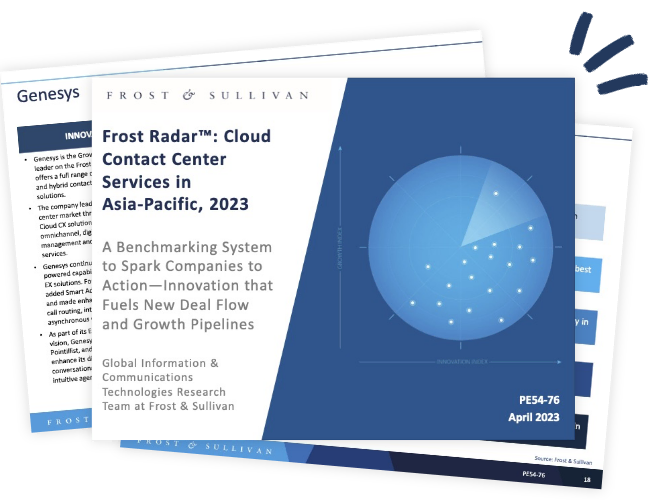Your Genesys Blog Subscription has been confirmed!
Please add genesys@email.genesys.com to your safe sender list to ensure you receive the weekly blog notifications.
Subscribe to our free newsletter and get blog updates in your inbox
Don't Show This Again.

Market swings are nothing new. However, today we see volatility all around us: supply chain challenges, spiking energy costs, inflation, geopolitical concerns, evolving regulations and changing interest rates.
Financial services experts at Genesys expect these conditions to continue, certainly through the first half of 2023. This impacts investor confidence, financial planning and economic stability. And this means that customers will contact banks more in 2023 — and expect to connect across a growing array of digital channels. Leading banks will also be innovating their outbound solutions to better serve their customers.
While many banks are attempting to provide more personalised solutions, plenty of challenges remain. Seventy-four percent of banking customer experience (CX) leaders say that more personalisation leads to greater customer loyalty, but 54% believe consumers see their attempt at personalised services as generic, according to a new FT Longitude report.
Here’s what financial services experts can do to reassure customers, minimise risks, create a positive customer experience and make good investment decisions in a volatile market.
Consumers want to interact with their bank using their preferred channels. Generation Z and millennial customers prefer online and mobile interactions; they also use these digital channels far more than baby boomers.
No matter their age, consumers want advisors to know them and be there at the moment of truth with the most personalised solutions. But when banks use channels that are inconsistent or operate somewhat independently, customers across the board become frustrated. Many will resort to calling the bank for assistance. And without highly trained agents ready to answer those calls, this can be a problem — especially in a tough job market.
Banks must be able to coordinate every touchpoint and interaction along the customer journey — in real time — based on the experience they want their customers to have. This is “Experience Orchestration.”
Let’s bring this to life with an example. The Wealth Management business has traditionally been based around the advisor. And the advisor likes clients to call them. Advisors viewed new tools like digital self-service capabilities and robo-advisors with some suspicion — and as a threat to the customer relationship. But things have changed.
Let’s say an advisor has Mick Jagger as her client. Mick wakes up on Monday morning and buys 10,000 shares in Apple himself — on his bank’s app in real time. He’ll transfer the funds to his trading account on his phone. And he’ll text his advisor to tell her he thinks Apple is a great buy.
Then he’ll still call his advisor to tell her what he wants to do tomorrow. So, Mick’s advisor sets up a 30-minute video call on Wednesday where she hears about his ideas for Latin America Fixed Income, and places real-time trades on his behalf.
All these devices, patterns and actions are better for Mick, the advisor and the bank if they’re all connected (and monitored to meet SEC/FINRA regulations). That’s why it’s so critical to design them to interact seamlessly — and to coordinate every transaction, channel and data flow in real time.
In banking, the traditional approach to customer service has been delivering against functional objectives like underwriting, service delivery and branch management.
But true personalisation comes from delivering empathy at scale. In banking, customers tend to assess their bank by the quality of their interactions when they first encounter an issue. That’s why ensuring this experience is excellent and seamlessly linking a great digital self-service experience with a live-person conversation is a priority.
Let’s illustrate this with another example. In banking, collections activity — calling up clients who are behind in their loan payments — has traditionally dominated outbound contact strategies. Now recessionary factors are driving investment in collections, an area of banking not known for innovation. But that’s changing.
While consumers often find loan delinquency difficult and embarrassing, they often feel more comfortable engaging with a bot or through text messages. Ideally, the bot can listen to the journey as it’s happening, personalise the conversation based on journey context, and then seamlessly transition the conversation to an advisor, if necessary.
Many banks have traditionally had a disjointed employee engagement strategy. They’ve conducted annual employee surveys, perhaps noted their progress and continued on. Living with a 25% attrition rate was simply the cost of doing business.
But today, banks are finding it difficult to fill their job requisitions in the front, middle or back office. And back-office job roles are changing.
As automation and self-service increase, back-office demands will require higher skills levels — and more experience, licensing and certification. Also, hybrid working models require more flexible work tools and supervisory capabilities.
For banks, this all represents a change in mindset — the importance of work environments reflecting how we live. Banks now see their key competitors for top new talent not as other banks — but as Google, Microsoft or a tech startup. Adding to the challenge is that employees are no longer restricted by geography when it comes to choosing their employers.
And with the acceleration in digitising the modern workplace, training is increasingly important. For example, video advising — training remote employees via video — seemed unthinkable for advisors in banks just months ago. But now it’s a reality in the relationship between bank employees and managers.
Employee engagement has become just as important as the customer experience. Half of the companies are working on reducing turnover rates with flexible hours, increasing compensation and resources such as agent analytics, supervisor coaching, career planning and gamification.

Genesys ranks highest in growth and innovation
All these factors are putting increased pressure on operating efficiency. This means banks will continue to invest in new technologies that make staff more efficient, improve sales models, and remove costs and disruptions from personalised service experiences.
This quest for efficiency requires investment in large-scale operational improvements. As products become even more commoditised, personalised service at scale will power banking differentiation more than ever.
Personalisation means more than knowing a person’s name when they call. That’s friendly, but not always helpful. Rather, personalisation means banks have all the information and tools ready instantly for whenever a customer has an opportunity or an issue.
Addressing flaws in measurement systems and the voice of the customer is important. A bank might observe a 90% FCR in their call centre — and that’s great. But it’s not helpful if the call volume is caused by a problem on the bank’s mobile app that the customer couldn’t fix by going to the bank’s website. That means executives aren’t clearly seeing defects in their customer experience. In other words, important customer experience issues, breakages, inefficiency and rework can be missed if you don’t understand the full journey.
Ultimately, artificial intelligence (AI)-driven personalisation will help predict customer needs and suggest solutions before customers are even aware. These journeys propelled by data and behaviour are becoming even more important this year. More than three-quarters of business leaders worldwide agree that AI will be a critical part of their CX operations in the coming years, according to “AI Comes of Age,” a global research report by Economist Insight.
Forty-four percent of banking executives say investing in new technology to drive customer understanding and personalisation is the most important transformation that will drive their business in the next two to three years, according to the FT Longitude report. Here are some key ways to prioritise your banking CX.
Accelerate digital capabilities: Traditional initiatives at banks can take three years to deliver. Banks must shape new digital-first products and services that customers want. Now.
Evolve to the cloud: A modern cloud platform allows you to meet your unique requirements, maintain your strategic partnerships and innovate at a speed that’s impossible with on-premises solutions.
Think about milestones: Consider your roadmap milestones from the customer perspective. Then determine the tangible experiences that will differentiate your company and compel customers to use your products and services.
Create seamless connections: Craft a solution that connects your contact centre to your business-critical systems. You can streamline your operations with custom integrations that connect the bank, customer and advisor.
Examine innovations at other banks: If you’re JPMorgan Chase, this doesn’t mean studying Bank of America. It means researching what banks — or other organisations — are doing in other regions around the world in order to keep pace with consumer expectations and differentiate your bank.
Explore other industries: Don’t keep asking your customers what they want from a bank; they’ll tell you “better service, lower fees and kinder people.” Rather, ask your customers about the delightful, unexpected experiences they’ve had in their daily lives. Then go explore these experiences and consider how it relates to your offering — and whether you can create a similar feature or function.
Your customers expect far more than for you to simply know their names when they call. They want seamless coordination of every interaction regardless of their need, the time or the channel. And that’s what’s at the centre of Experience Orchestration.
Subscribe to our free newsletter and get the Genesys blog updates in your inbox.